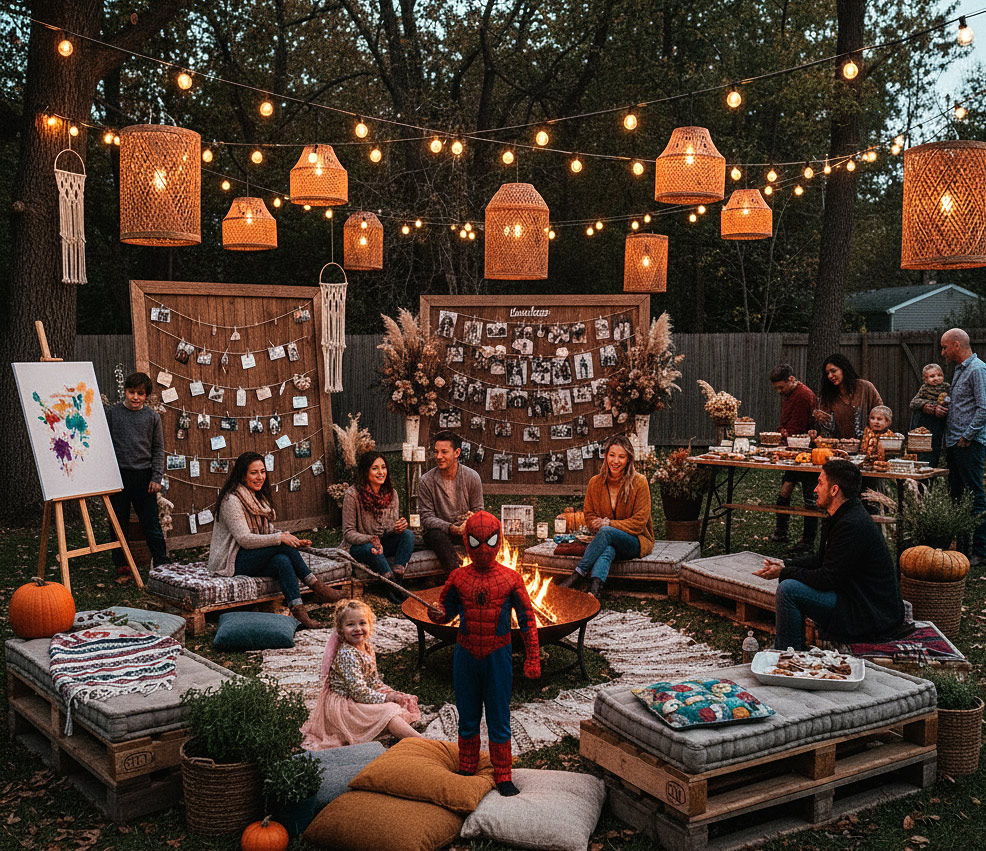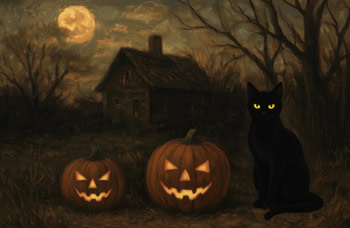
Reset Halloween: Reclaiming All Hallow’s Eve
Remember, remember the end of October! ‘Tis the season of superstitions! Deck we our homes like pumpkin-invested haunted playgrounds. Then let us enact “The Purge” (Brought to you by Cadbury and Hershey)! Goblins and psychopaths stalk our youngins dressed like prostitute witches and serial killers as they devour enough sugar to incite a diabetic coma.
Let’s make it bigger than Christmas! We’ll start before Labor Day and celebrate ’til Black Friday, or at least until the candy runs out.
But we don’t have to. Millions of Americans are rightly deciding this pagan campaign to celebrate death has become too commercialized, too slutty, too last century. Instead of turning out the lights and leaving a basket on the stoop to appease the pagan hordes, perhaps it’s time to affirm that Halloween, properly understood, is historically, a Christian Feast, and worth a cultural reset.
The Truth of All Hallows’ Tide
Consider the name itself: Halloween is derived from “All-hallow-eve,” the eve of All Saints Day. The entire Catholic calendar includes All Hallows’ Eve (October 31st), All Saints’ Day (November 1st), and All Souls’ Day (November 2nd)—is known collectively as Allhallowtide.
“But wait,” you say, “Halloween is just a churchified pagan holiday!” While many do associate October 31st with the ancient Celtic harvest festival known as Samhain, or the Druid’s and their cult of death and so forth, Halloween is overrun by bad scholarship, bigotry, and modern advertising. And horror films that bear its name.
All Hallows can also be viewed as a Christian holiday traced to the 8th century. A few dates for you:
- Since the mid-300s, Christians celebrated All Saints’ Day (Hallowmas) on May 13 to honor all martyrs and saints.
- The November Shift: Despite any circulating papal conspiracies, rescheduling Hallowmas to November 1 did not originate in Rome or Ireland, but in Germany, where locals found autumn a fitting time to contemplate death. Pope Gregory III (731–741) approved November 1st for the Church in Rome, and then Louis the Pious expanded to his Frankish empire in 835.
- Prayers for the Dead: The third day of the triduum, All Souls’ Day (Commemoration of All Faithful Departed), was popularized by Abbot Odilo of Cluny (998 AD) to pray for the dead in purgatory.
Okay, but what does that have to do with us?
Resetting This Celebration of Virtue
Autumn is a season of gathering the harvest and reflecting on our lives for the Fall and Winter ahead. So why should we concede the time to “Trick or Treat” commercial advertisers?
Allhallowtide—the days of All Hallows’ Eve, All Saints’ Day, and All Souls’ Day—calls us to remember the past, honor our ancestors, and renew our moral footing as a people.
- Mindfulness of Mortality (Memento Mori):
Remembering that life will end helps us live rightly. Communities and churches once taught this truth through symbols and art, reminding us all that no one escapes judgment or our (good or bad) legacy. The purpose was not to instill dread but perspective—to live wisely, work faithfully, and prepare for what lasts beyond this life. - Reverence for Heredity:
Remembering the faithful departed keeps families and communities anchored. Telling their stories keeps history alive and gives context to our present. And creating family or community rituals helps younger generations grow into strong, virtuous, and patriotic Americans able to face the future. - Gratitude for the Harvest and Those Who Provide It:
Yes, Thanksgiving is coming, but we should also cherish those you bring in that harvest. Remember to thank and support our farmers who sustain our communities through hard labor, stewardship, and faithfulness to nature’s rhythm.
So how do we reset, to replace empty spectacle with substance? Our celebrations should reflect gratitude, remembrance, and community—not indulgence or fright. In doing so, we honor our history and strengthen the moral and spiritual ties that make us who we are.

Rather than accept the drift toward mindless consumption and hollow thrills, we choose a different course. Our autumn traditions can be meaningful, rooted, and community-minded.
- Restore the Practice of Souling
Bring back souling—the original act of door-to-door charity and prayer. Instead of trick-or-treat, families can offer small cakes or notes and pray quietly for those who have passed. This revives a tradition that focused on care for both neighbor and community memory. Soul cake recipe below! - Host Safe, Community-Focused Events
Organize controlled gatherings: fall festivals, trunk-or-treats, or harvest dinners. These events provide fellowship, safety, and a chance for every age to reconnect with neighbors. The focus shifts from fear to togetherness and gratitude. - Reconnect with the Land and the Harvest
Seek out ways for families—especially children—to connect with the season’s work. Visit a farm, pick apples, or volunteer at a local food drive. Recognize and thank those who provide our food. If you can, support farmers or local agriculture. - Starting “gratitude walls”
Your church community board could be where people write notes of thanks, including specific notes of appreciation for farmers and local food producers - Make Light and Remembrance Central
Choose light over darkness. Host a candle-lit vigil, set up a family altar, or gather stories of departed loved ones. If possible, visit cemeteries or hold a simple family prayer at home. These acts build gratitude, memory, and hope. - Give Back Generously
Take autumn as a moment for service. Collect food, clothing, or donations for those in need. Encourage children to participate so they learn early that community is built through generosity, not just celebration.
What else? While the rest of our disjointed culture parades their dread around (look out for bloody Charlie Kirk “freedom” t-shirts!), we can do more than thankfully recall who we leave behind. We should keep looking ahead to resetting all of our holidays for our children so that they are well-adjusted, resilient, and brave.
Getting Started: Try a Soul Cake Social
Challenge the modern, consumerist candy-glutting pageantry with an English Catholic door-to-door tradition of “souling,” the purer form of modern “trick-or-treating”. Traditionally on All Souls’ Day (or All Souls’ Eve), beggars, also known as ‘soulers,’ or children would go door-to-door, begging their neighbors for a “Soul Cake”.
In exchange for the treat, they would say a prayer for the family’s dead.
“A Soul Cake, a Soul Cake, have mercy on all Christian souls for a soul cake!”.
Set up a café set next to your candy bowl on Halloween, and offer a quick chat, cider and soul cake.
Soul cakes are sweet, round, thick biscuits, flavored with mixed spice and containing raisins or currants. The following recipe is adapted from English tradition.
Prep Time: 10 minutes Cook Time: 15 minutes Yields: 20 cakes
Ingredients
- 175 g Butter (unsalted, softened)
- 175 g Golden Caster Sugar (or granulated sugar run through a coffee grinder to refine it)
- 3 Egg Yolks (from large eggs)
- 420 g All Purpose Flour
- 1½ teaspoon pumpkin pie spice
- ¼ teaspoon Allspice (optional)
- 2 tablespoon Milk (full-fat recommended, just enough to bring the dough together)
- 50 g Raisins or currants or chopped dried cherries
Instructions
- Preheat the oven to 180°C (160 fan/Gas 4/350F) and line two large baking sheets with baking paper.
- Cream together the butter and sugar until the mixture is pale and fluffy (use an electric mixer or cream by hand).
- Beat in the egg yolks.
- Stir in the flour, mixed spice, allspice, and raisins.
- Add just enough milk (one tablespoon at a time) to bring the dough together by hand. The dough should come together easily but not be too soft or sticky.
- Roll the dough out on a liberally floured surface to the thickness of two £1 coins. Use a 5cm fluted cookie cutter to stamp out the rounds.
- Carefully place the biscuits on the lined baking trays and mark a cross on each with a knife.
- Bake in the oven for 13–15 minutes until lightly golden. Leave them to cool for 5 minutes before removing them to a wire rack.
Enjoy soul cakes with a cup of tea or a glass of milk.
If you’re bold enough, wrap the cakes in a paper describing your reasons for resetting Halloween and hand them out instead of candy. Be prepared for tricks if they don’t find it to be a treat.
Stay in Touch
Reducing the impact of leftism, statism, and other negative influences can be difficult. Let’s do it together.
If you have suggestions for resetting our cultural conversation, or just want to be kept up-to-date, send me a question or comment.
Reset Culture


